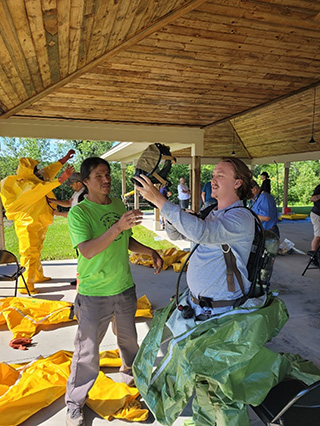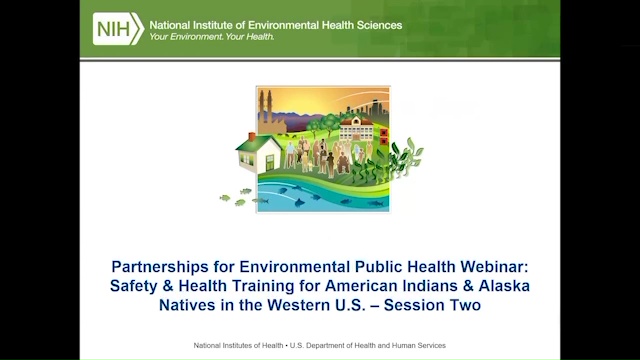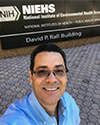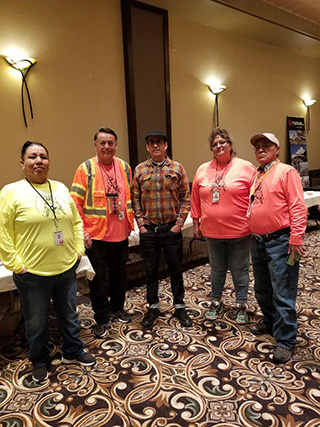Partnerships for Environmental Public Health (PEPH)
January 10, 2023 • 2:00 p.m ET

In this webinar, we heard from two NIEHS Worker Training Program grantees who are providing health and safety training to Native American Tribes. The first presentation was given by Alabama Fire College and the Saint Regis Mohawks. The second presentation was given by the United Steelworkers – Tony Mazzocchi Center.

Presentation One: Partnership Brings Emergency Response and Disaster Training to Native American Tribes
Workplace Safety Training: A Division of the Alabama Fire College (1MB)
PEPH Webinar: Safety and Health Training As a Partner: The Saint Regis Mohawk Tribe (3MB)
In the late 1990s, conservation officers from the Mississippi Band of Choctaw Indians attended a 40-hour Hazardous Waste Worker course offered by the Workplace Safety Program (WST) through funding from the NIEHS Worker Training Program. The officers recognized the risk of encountering illegal toxic waste dumps on tribal lands and approached WST, now a division of the Alabama Fire College (AFC). The conservation officers and WST partnered with the Native American Fish and Wildlife Society (NAFWS) to take hazardous materials and disaster response training to tribes throughout the United States.
This presentation described the partnership of AFC and NAFWS to take hazmat, environmental, and disaster response training to Native American emergency responders and other tribal workers. The presenters looked at the program broadly and then highlighted the work with one tribe, the Saint Regis Mohawks (Saint Regis), to describe how the work has benefitted communities beyond the tribal lands in upstate New York. Saint Regis’ response capacity has grown as a direct result of AFC’s programs, enabling its own tribal members to work safely in hazardous environments as well as taking on leadership roles and participation in regional response planning with federal and state agencies.

Roy Stover is an Air Force veteran and has over 20 years of experience in training first responders nationally and internationally in a variety of hazmat and emergency response subjects. Stover is a senior instructor and the Native American Training Coordinator at the Workplace Safety Training Program, a division of the Alabama Fire College.

Leslie Benedict is assistant director of the Environmental Division of the Saint Regis Mohawk Tribe located in upstate New York. He has developed and implemented tribal programs in air quality, hazardous materials emergency response geographical information systems, hazardous waste management and site remediation, and wildlife assessment and management. He serves as tribal liaison to local, regional, and federal environmental and emergency management agencies. He is an instructor in homeland security, hazardous materials emergency response, and sportsman safety programs. He also plans, writes, and manages federal grants and projects for the tribe. He works hard to preserve the tribal environment and lands and to facilitate their cooperation in the region.
Presentation Two: Radiological Control Technician Education for Tribes
USW-TWC Radiological Control Technician (RCT) Training Program for Hanford Area Tribes (1MB)

The Steelworkers Charitable and Educational Organization (SCEO), the nonprofit entity of the United Steelworkers (USW), supports a training partnership linking two of the largest U.S.-based industrial unions with rapidly expanding immigrant worker centers. The Tony Mazzocchi Center (TMC), the SCEO's training body, brings together the USW, the Communications Workers of America, the Labor Institute, the National Day Laborer Organizing Network, and Make the Road New York. The TMC provides workers and community residents with training to help prevent toxic releases, fires, explosions, injuries, sickness, and death.
This presentation gave an overview of the USW TMC’s 240-hour Junior Radiological Control Technician (JRT) training program with the Umatilla, Yakima, and Nez Perce tribes in the American northwest. It described the JRT training, the emphasis on recruiting tribal youth, and post training activities including Radiological Control Technician training.

Rodrigo Toscano is a bilingual (Spanish/English) senior coordinator for labor and environmental education. He has worked for the Labor Institute since 2000. He is a certified OSHA trainer in construction and general industry. He is also a NIEHS certified trainer (proficient in over 30 health and safety specialized topics). He is the lead DOE liaison for United Steelworkers and northwestern tribes (Cayuse, Umatilla, Walla-Walla, Yakima, Nez Perce), curriculum editor and translator, an evaluator and writer for the Tony Mazzocchi Center, forum co-director for New York Immigrant Worker Centers/Labor Institute monthly forum, and chief logistics coordinator for the Specialized Emergency Response Trainers. Prior to joining the Labor Institute, Toscano was vice president of the San Francisco chapter of statewide social workers union (SEIU 535) and a delegate to the San Francisco Labor Council.
We Want Your Feedback!
Send comments, questions, and suggestions for future webinar topics to [email protected].


